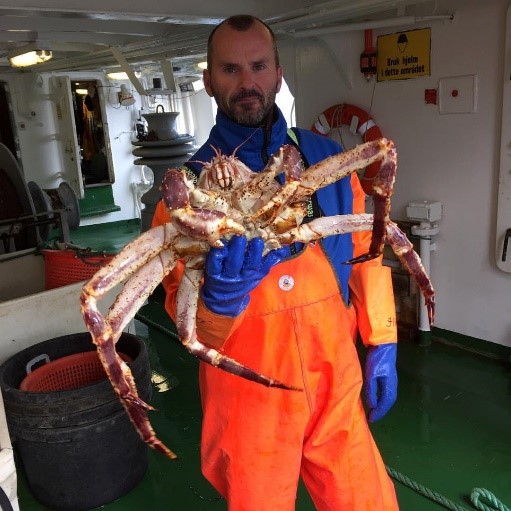What scientific topics do we work with?

A goldsinney wrasse ready for sampling
Photo: Eeva JanssonGenetic and ecological interactions between farmed escapees and wild conspecifics
Farmed escapees and genetic interactions with wild conspecifics represents a persistent and major challenge to an environmentally-sustainable aquaculture industry. An overview of current knowledge was recently published in a comprehensive review article in Fish and Fisheries 1. The group has had a long-term and diverse research profile in this field, including examples such as: common-garden experiments to elucidate the genetic and genomic differences between domesticated and wild salmon 2-15, quantifying patterns of introgression of farmed escapes in natural populations 16-20, behavioral studies to understand the movements of farmed escapees 21-24, field experiments with domesticated and wild salmon 20,25,26, and genomics approaches to quantify differences 27-29. The group also lead the National Monitoring Program for quantification of farmed escapees in the natural environment 30,31, has published the most up to date risk assessment for future genetic introgression in wild salmon populations in Norway 32, and has published multi-disciplinary studies on the ecological profile of escapees entering rivers 33,34. The group has also developed and implemented an eco-genetic model to investigate the potential genetic changes expected in wild populations following spawning intrusion of domesticated conspecifics 35,36.This field remains as a major part of the groups research profile.
Population genetic (genomic) structure and function
The group has a long history of using molecular genetic methods to study connectivity among populations of fish and other organisms in the marine environment. This has ranged from some of the smallest (e.g., copepods) to the largest (whales) animals in our seas. Many of these studies have been designed to address important fisheries management questions, while others have tried to identify important mechanisms maintaining genetic structure, such as bathymetric and seascape features, oceanic currents and geographic distances. One of the species that has been most intensely studied by the group over several decades is the Atlantic cod 37-58. Population genetic and genomic studies have also covered a wide range of species including: European hake 59, grenadier 60,61, redfish 62-69, coalfish 70,71, Greenland halibut 72,73, tusk 74,75, ling 76, ballan wrasse 77-79, goldsinny wrasse 80,81, corkwing wrasse 42,82-84, shrimps 85-87, sea lice including development and dispersal of resistance genes 88-95, Atlantic salmon 16,17,96,97, residential and anadromous brown trout 98-101, minke whales 102, Portuguese dogfish 103, European sprat 104-106, haddock 107, Plar cod, European lobsters 108-110 and snow crab in the Barents sea (Dahle et al., submitted). In addition, there are ongoing efforts to map the population genetic structure of a number of previously unstudied or poorly studied species. This remains as a major part of the groups project portfolio and is using to an ever-increasing degree genomics tools to provide greater clarity to the scientific questions at hand 44,89,111.

Photo: Jon-Ivar Westgaard
Marine Protected Areas (MPAs): development, function and evaluation
Genetic, ecological and behavioral methods have been combined in multi-disciplinary studies to evaluate MPAs. Much of this work has occurred in the south of Norway on cod and lobster where dwindling wild populations and high levels of anthropogenic pressure has led to increased focus on MPAs as a way of conservation 108,112-115. Some of this works have led to innovative thoughts regarding the function of MPAs, such as how protection-induced selection and contemporary evolution could fundamentally alter our perspective on MPA function 116-118.
Ecological and opportunistic studies
Not all of the group's research activities are directly related to population genetics, and a range of ecological and opportunistic studies have and continue to be managed by the group. Some of these of course overlap with evolutionary questions where genetics tools have been implemented or will to an increasing degree be implemented in the future.Some of these studies are also related to investigating the genetic differences among populations using experimental rather than population genetics approaches. These highly diverse group of studies include examples such as investigating susceptibility of various populations to infection with the salmon louse including computation of heritability 119-121, identification of unintentional spontaneous triploidy in farmed populations 122,123, determining how the third set of chromosomes influences the phenotype of triploid salmon 8, investigating the role of sea lice on marine mortality of Atlantic salmon and anadromous brown trout populations 124-128, investigations of evolutionary fishing pressure on a salmon population 129, quantification of fitness differences among sea lice families in response to chemical and environmental stressors 130, telemetry studies to track fish movements and behavior in relation to various environmental factors for example sea temperature 22,51,131-133, tank behavioral studies 5, developmental deformities such as conjoined twin development in salmonids 134, identification of resistance development and dispersal mechanisms in parasites 89, and links between movement ecology and climate change mitigation 135,136.
eDNA and molecular diet analysis
The analysis of environmental DNA (eDNA) has in the last decade proven to be a robust and valid method for characterizing biodiversity in the marine environments. The analysis involves massive parallel sequencing of DNA traces shed by the organisms living in the environment. In the marine environment these DNA traces are sampled by either from the water column or sediments. The eDNA work in the group is mainly focusing on developing tools for monitoring fish communities, but we are also working with species diversity among benthic invertebrate communities through the MAREANO project.
Related to eDNA, molecular diet analysis involves massive parallel sequencing of DNA extracted from stomach and/or intestine content of animals. The benefits of applying molecular methods are especially pronounced for pelagic feeders and animals which crush their prey, making it hard to visually identify prey items.
References: Key publications from the IMR Population Genetics group.pdf
Published: 01.03.2022

